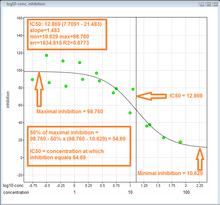IC50
The mean inhibitory concentration (IC50) is the concentration of an inhibitor (synonymously inhibitor) at which half-maximal inhibition (half-maximal inhibition) is observed. The dose-response curve is sigmoidal, so a concentration with maximum effect occurs only at comparatively high concentrations. Therefore, the value near the inflection point is taken. For example, if an inhibitor has 50% of the maximum inhibitory effect at 100 nanomoles/l, this would be the IC50.
In pharmacology, the IC50 is used to indicate the potency of an antagonist. This is comparable to the EC50 of an agonist.
According to the FDA, the IC50 is the concentration of a substance necessary for 50% inhibition in vitro. The EC50 also indicates the plasma concentration necessary for a 50% effect in vivo.
For competitive inhibitors, the IC50 or EC50 depends on the Michaelis constant Km, the dissociation constant of the enzyme-inhibitor complex Ki, and the substrate concentration [S], represented in the Cheng-Prusoff equation:
Since the IC50 value is expressed in nanomolar (nM) or micromolar (µM) and is therefore somewhat unwieldy, the so-called pIC50 value is also used. It is calculated from the IC50 value by forming the negative decadic logarithm from the numerical value of the concentration in mol/l.
Example:
Other numerical values, for example IC95 indicate the concentration necessary to inhibit 95%.

Graphical determination of the IC50 using example values
See also
- Enzyme kinetics
- Enzyme inhibition
- Catalytic efficiency
- EC50
- LD50
Search within the encyclopedia
![{{\text{IC}}_{{50}}}=\left(1+{\frac {[{\text{S}}]}{K_{m}}}\right)\cdot K_{i}](https://www.alegsaonline.com/image/63c9751a894826d8852ddc2e70b82c1c1f251217.svg)
